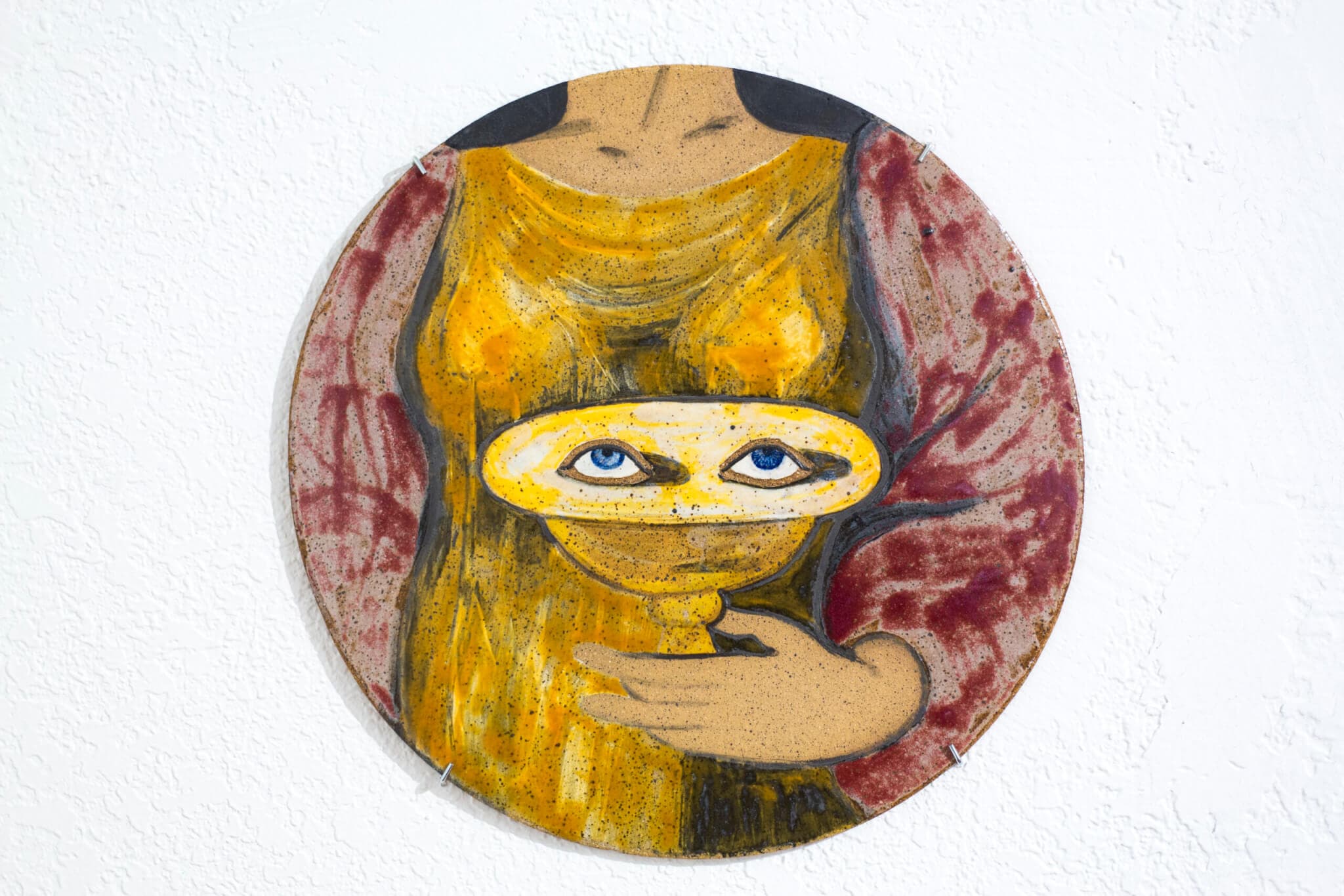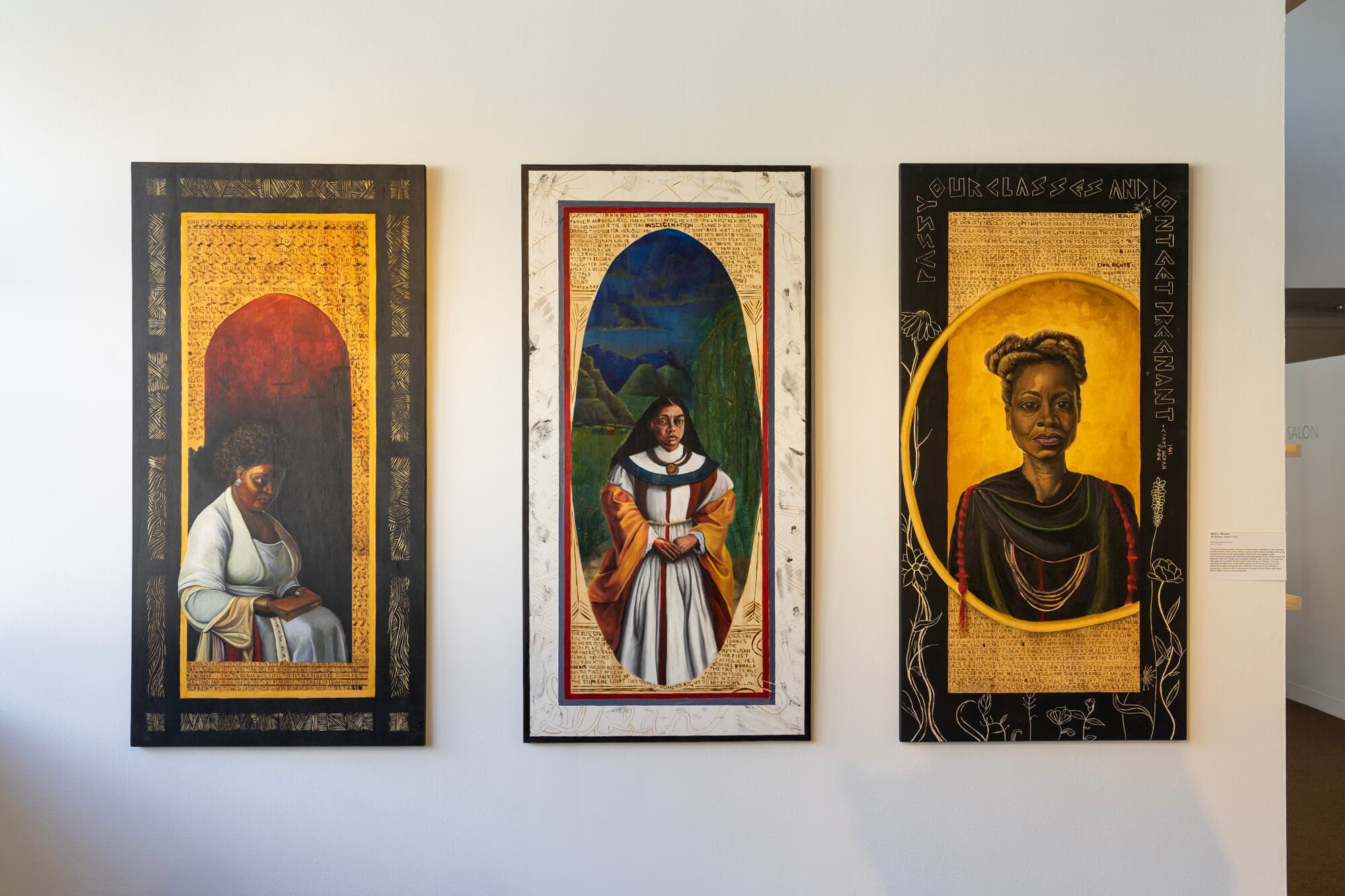Online Only• Jan 19, 2024
Taking Back the Narrative(s): “Deeply Rooted: Faith in Reproductive Justice” at Brandeis’ Kniznick Gallery
Twenty-one artists respond to the overturn of Roe v. Wade in the Supreme Court and shattered reproductive healthcare access across much of the US. Curated by Newton-based artist Caron Tabb, the multidisciplinary exhibition excavates the deep-rooted relationship between religion and reproductive justice.
Review by Melanie Litwin
Installation view, “Deeply Rooted: Faith in Reproductive Justice,” Kniznick Gallery, Hadassah-Brandeis Institute. Curated by Caron Tabb. Left to right: Cora Ramirez-V, Andi Arnovitz, Dell M. Hamilton, Zoë Buckman, Safarani Sisters, Susan Chen. Photo by: Elizabeth Ellenwood.

Installation view, “Deeply Rooted: Faith in Reproductive Justice,” Kniznick Gallery, Hadassah-Brandeis Institute. Curated by Caron Tabb. Left to right: Cora Ramirez-V, Andi Arnovitz, Dell M. Hamilton, Zoë Buckman, Safarani Sisters, Susan Chen. Photo by: Elizabeth Ellenwood.
In a silent gallery, this exhibition shouts.
I visited “Deeply Rooted: Faith in Reproductive Justice” at Brandeis University’s Kniznick Gallery on its first day open in the New Year—an exceptionally quiet day. In the stillness, the collection felt particularly intimate. With no other visitors’ bodies obscuring the artworks, I was able to see the room in its entirety. Each piece was simultaneously in conversation with one another, their collective power speaking volumes.
“Deeply Rooted: Faith in Reproductive Justice,” curated by Newton-based mixed-media artist Caron Tabb, is a multidisciplinary response to the Dobbs v. Jackson Women’s Health Organization decision that overturned Roe v. Wade and shattered reproductive healthcare access across much of the US. The exhibition centers, and then promptly refutes, Supreme Court Justice Samuel Alito’s declaration that “the right to abortion is not deeply rooted in the nation’s history and traditions.”
Justice Alito’s sentiment creates a limited narrative that attempts to position itself as objective truth—grossly ignoring the subjectivity of human experiences and the diversity of traditions that exist. Drawing on many different perspectives and experiences, twenty-one artists come together in “Deeply Rooted” to challenge that narrative and disrupt rigid binary thinking. Despite the exhibition’s reference to faith, it extends beyond religious beliefs, telling a story of complex entanglement between personal identity—whether it be through culture, history, or religion—and reproductive justice.

Giovanna Pizzoferrato Ribeiro, Portrait of Saint Lucy Holding Her Own Eyeballs, 2021. Glazed ceramic, 12.25′ diameter. Photo by: Amy Shelton.
At the front of the gallery, directly adjacent to the exhibition’s introductory description, Giovanna Pizzoferrato Ribeiro’s Portrait of Saint Lucy Holding Her Own Eyeballs (2021) embodies the principle that the hegemonic narrative is far from the only one. The flat ceramic disk features Saint Lucia, or St. Lucy, a virgin martyr who is said to have been so steadfast in her faith that she removed her eyes rather than break her vow of chastity. Ribeiro represents St. Lucy from the neck down, adorned in a vivid gold and holding her eyes on a golden dish. The eyes appear to look up at us, questioning how we see St. Lucy. Or perhaps challenging us. While the glazed ceramic itself is not large—only approximately 1 foot in diameter—its presence is striking.
There are many existing renditions of St. Lucy, but Ribeiro imbues this piece with her own style and meaning. She draws on the dualities existing in her personal background, as well as the subjectivity of religious meaning. In the accompanying artist statement, she describes, “To me, Lucy is the patron saint of, ‘No, I will not be your baby maker. I’d rather pluck out my own eyes, Sir.’ While Catholics revere her for maintaining her virginity, I admire Lucy for defending her reproductive rights.” Even when it comes to a singular religious figure, a myriad of meanings can be derived, born from an individual’s background and belief systems. A singular interpretation—of anything—is rarely possible.

Charlie Dov Schön, Post-Roe Protection Amulet, 2023. Felt, norgestimate (birth control – brand Sprintec), beads, ribbon, lace, thread. 5′ x 2′.
Charlie Dov Schön similarly reimagines religious meanings, in this case via ritual objects. Post-Roe Protection Amulets (2023) is a collection of five palm-sized “amulets” made from soft materials such as felt, lace, and—notably—birth control pills. Hung against the wall with ribbon, the amulets are stylistically similar, yet each vary in exact shape, color, and design. Visually, they evoke traditional Jewish amulets of protection.
Here the amulets have been redefined for our contemporary times as a means of pro-choice protection. However, displayed in this setting, they hang against the wall, unable to protect a wearer. Pessimistically, I am inclined to see this as an omen of the struggle ahead; we were not protected when Roe v. Wade was overturned and we will not be protected in the face of state attacks on reproductive care. At the same time, maybe these amulets are simply waiting for us, ready to comfort and protect us in this fight as soon as we let them.

Marla L. McLeod, My Mother’s Keeper, 2023. Oil, burned and carved wood, 48′ x 72′. Installation view, “Deeply Rooted: Faith in Reproductive Justice,” Kniznick Gallery, Hadassah-Brandeis Institute. Curated by Caron Tabb. Photo by: Elizabeth Ellenwood.
Across another wall of the gallery, a set of three large painted portraits are prominently displayed. Through My Mother’s Keeper (2023), Marla L. McLeod highlights the specificity of human experiences and belief systems. Each portrait portrays a maternal figure from McLeod’s personal life, and each figure has their own beliefs, cultures, and experiences of historical events visually demonstrated in the carvings around the portraits. When seen side by side, as they are intended to be, the set communicates a sense of power and influence, as they all had a role in shaping McLeod’s childhood.
Winnie van der Rijn’s Tactical Survival/Prophylaxis’ (Uterine Armor 11 – Because Hope Is Not a Strategy) (2023) creates its own world of duality. The seemingly wearable green camouflage bloomers are suspended in the space from a clothing hanger, with “tools” of self-defense against a lack of reproductive rights fastened to them—including cash, condoms, Plan B, a self-defense manual, pepper spray, and drink tests. The uterine armor pushes and pulls across seemingly oppositional lines, as Rijn’s feminist perspectives meet her conservative military upbringing. Despite being “armor,” which may imply a certain hardness and resistance, the fabric has softness to it. The waves of material create a sense of light and fluidity, both figuratively and literally, as light is able to shine through from behind the piece. The traditional feminine and domestic creation of the uterine armor with needle and thread also contrasts with the masculine and military associations with camouflage and armor—especially as the state is the very entity imposing restrictions on reproductive care.

Installation view, “Deeply Rooted: Faith in Reproductive Justice,” Kniznick Gallery, Hadassah-Brandeis Institute. Curated by Caron Tabb. Left to right: Diana Weymar (Tiny Pricks Project), Zoë Buckman, Susan Chen, Cora Ramirez-V, Dell M. Hamilton. Photo by: Elizabeth Ellenwood.
Nearby, Susan Chen’s Free Tampax (2023), a ceramic life-sized tampax box, rests on a plinth, allowing for a full 360 view. The box—complete with tampons sticking out of it and an adjacent ceramic sign declaring “FREE”—feels permanent and sturdy, yet the same cannot be said for reproductive rights. In the context of the global stigma surrounding menstruation and sex education, which Chen experienced throughout her own upbringing, it is subversive to be having these conversations so loud and so publicly in a gallery. While the back of the box advertises the tampons as “Out of Sight, Out of Mind,” the artwork itself situates menstrual justice as very much in sight and front of mind. Chen disrupts the separation between the public and private spheres, bringing the “private” into the “public” and blurring the lines between the two.
Two other large, mixed-media sculptures also have a strong presence in the gallery—Dell M. Hamilton’s Deeply Rooted After Dobbs (2023) and Zoë Buckman’s According to Grandma (2019)—both of which are suspended from the ceiling. The former brings together a range of materials, including tulle, thread, finger cots, an anatomical pelvis, and blue synthetic hair, to build a thin tubular structure that towers over an open Bible. Spilling onto the Bible are shredded strips of paper: a copy of the Dobbs decision. Though the piece hangs inert, the composition reminds me of something alive, growing out of the ashes of what has been lost.
In According to Grandma, twelve hanging boxing gloves are covered in domestic fabrics, including linens belonging to Buckman’s grandmother. The work reaches toward past generations of Jewish women, while simultaneously challenging the dichotomy between vulnerability and strength, protection and harm. As I circled the piece, I wondered: What would past generations think of the current state of reproductive justice? And what responsibility do we have to future generations?
In the truest nature of art, “Deeply Rooted: Faith in Reproductive Justice” asks questions, rather than answering them. While the exhibition is limited in the number of experiences it can capture, it successfully breaks apart the idea of a singular narrative, living within the reality of complex truths. In the process, it dares visitors to hold multiple truths—and multiple meanings—at once. Only then do we even get close to understanding the deep-rooted relationship between religion and reproductive justice.
“Deeply Rooted: Faith in Reproductive Justice” is on view at at Brandeis University’s Kniznick Gallery through February 1, 2024.





